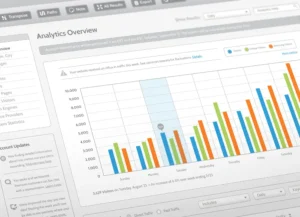WordPress is one of the world’s most popular content management systems. As of 2024, it powers 43.5% of all websites globally. Despite its flexibility and ease of use, beginners often make errors that undermine their site’s performance and growth.
In this article, we examine the top 10 mistakes people make when creating a WordPress site—and provide practical tips to prevent them.
Choosing the Wrong Hosting
Hosting is the foundation of your website. Cheap or unreliable hosting can lead to slow website loading times, frequent outages, and security vulnerabilities. It’s crucial to consider your specific needs and choose a package that provides the necessary resources for your site’s functionality.
Solution: Choose a reputable, WordPress-optimized hosting provider. Determine what services you need in advance and which provider will be the optimal choice for you.
Using a Generic or Poorly-Coded Theme
 Standard WordPress themes can be a good starting point, but they often lack sufficient functionality and design flexibility. Poorly coded themes, on the other hand, can harm your site’s speed and security. There are over 30,000 themes available in the official WordPress repository and on other software marketplaces.
Standard WordPress themes can be a good starting point, but they often lack sufficient functionality and design flexibility. Poorly coded themes, on the other hand, can harm your site’s speed and security. There are over 30,000 themes available in the official WordPress repository and on other software marketplaces.
It’s important to correctly define the functionality your site needs at the initial stage and select an appropriate theme. You should also consider important factors such as ongoing theme updates, support services, and general online resources for theme management and editing. Never start building a site on a theme whose last updates are several months old.
Solution: Choose a premium or well-coded free theme that has good ratings and regular updates.
Overloading with Plugins
 Plugins extend WordPress’s functionality and make it scalable, but using too many plugins can slow down your website and cause conflicts between the theme’s core and the plugins.
Plugins extend WordPress’s functionality and make it scalable, but using too many plugins can slow down your website and cause conflicts between the theme’s core and the plugins.
Every time you need a new feature, don’t just use a new plugin. Try to find an alternative solution through a simple Google search or by using artificial intelligence.
Solution: Use only essential and well-coded plugins. Regularly delete unused plugins. Never use unlicensed (cracked) pro versions, as this will put your site’s functionality and data security at risk.
Ignoring Website Speed
 Website loading speed is crucial for both users and SEO. A slow site degrades the user experience and negatively impacts search engine rankings.
Website loading speed is crucial for both users and SEO. A slow site degrades the user experience and negatively impacts search engine rankings.
Solution: Use caching plugins, CDN, optimized images (in Webp format), and plan your site structure correctly before starting the project.
Neglecting Mobile Optimization
 Today, most people use the internet on mobile devices; over 65% of internet traffic comes from mobile devices. If your website isn’t optimized for mobile, you will lose potential visitors.
Today, most people use the internet on mobile devices; over 65% of internet traffic comes from mobile devices. If your website isn’t optimized for mobile, you will lose potential visitors.
Solution: Ensure your theme is responsive (adaptive) and works correctly on various devices (tablet, desktop, mobile). Test your pages and posts on different resolutions before publishing.
Overlooking SEO
 If you want your website to be found by search engines, it’s essential to follow the basic principles of SEO during the site development process. Try to make the general structure and links of your site easily understandable for search engine bots.
If you want your website to be found by search engines, it’s essential to follow the basic principles of SEO during the site development process. Try to make the general structure and links of your site easily understandable for search engine bots.
Solution: Use SEO plugins (such as Yoast SEO or Rank Math), optimize your content with keywords, create a sitemap, meta descriptions, meta titles, a robots.txt file, and improve your site’s structure.
Skimping on Security
 WordPress, like any other CMS, can be a target for cyberattacks. Any system has bugs, and there is no unique code that won’t require updates after a certain period. Neglecting security can cause irreparable damage to your site and reputation.
WordPress, like any other CMS, can be a target for cyberattacks. Any system has bugs, and there is no unique code that won’t require updates after a certain period. Neglecting security can cause irreparable damage to your site and reputation.
Solution: Use strong passwords, keep WordPress, themes, and plugins updated, install a security plugin, and use an SSL certificate. Do not use unlicensed themes and plugins, and do not allow script execution from comments. The security structure of your chosen hosting also plays a significant role in site protection.
Not Creating Backups
 In case of any problems with your website, a backup will help you quickly restore your site and minimize downtime.
In case of any problems with your website, a backup will help you quickly restore your site and minimize downtime.
Solution: Regularly create backups of your website and store them in a secure location. There are several excellent plugins for this on WordPress, and you can also use cPanel.
Not Using Analytics
 Website analytics helps you understand how your visitors behave on your site and what you can improve. Statistics show you where you need to work and what priorities to set to enhance user experience.
Website analytics helps you understand how your visitors behave on your site and what you can improve. Statistics show you where you need to work and what priorities to set to enhance user experience.
Solution: Install Google Analytics and use it to measure your website’s effectiveness. You should link Google Site Kit to your Google Search Console account; it can also be connected with SEO modules to help you perform a comprehensive traffic analysis.
Stopping Content Updates
 New and engaging content attracts visitors and improves your site’s ranking in search engines.
New and engaging content attracts visitors and improves your site’s ranking in search engines.
Solution: Regularly update your website with new content and edit old materials.
By avoiding these mistakes, you can properly plan and create an effective, fast, and secure WordPress website.











